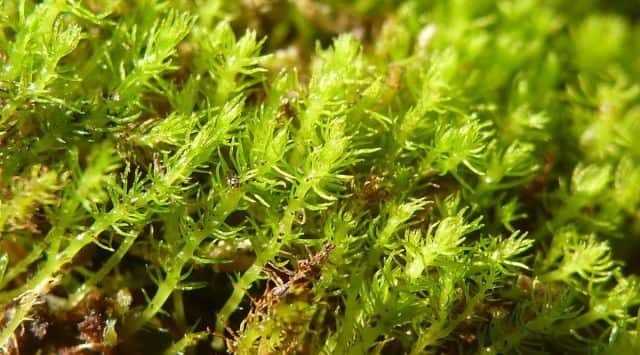Description

Disclaimer: Copyright infringement not intended.
Context
- Takakia stands as a remarkable example of a moss genus that has endured millions of years of evolutionary challenges to thrive in its unique habitat on the Tibetan Plateau.
- However, the swift impact of climate change poses a significant threat to this species, prompting researchers to assess its resilience and raise concerns about the survival of a living fossil in the face of a changing world.
Details
Introduction
- Takakia is a fascinating and distinctive genus of moss that holds a special place in the world of bryophytes (non-vascular plants, including mosses, liverworts, and hornworts).
- This genus is renowned for its remarkable evolutionary history, which links it to the early diversification of land plants, making it a key piece in the puzzle of plant evolution.
Taxonomy and Distribution
- Takakia is the sole genus in the family Takakiaceae, within the division Bryophyta. Its unique taxonomic position sets it apart from other mosses.
- Takakia is found exclusively on the Tibetan Plateau.
- Comprising only two species, this moss has endured for millions of years in a highly challenging environment, with long periods of snow cover followed by intense UV radiation exposure.
- The moss has developed specific genetic traits to survive these conditions, making it a remarkable example of adaptation.
Morphological Characteristics
- The most striking feature of Takakia is its resemblance to ancient fossilized plants. This moss has retained many primitive traits that make it a living relic of early plant evolution.
- Takakia appears in the form of small, densely packed, dark green cushions or mats, typically growing on rocks in moist and shaded environments.
- Each individual Takakia plant consists of simple, dichotomously branched stems, often less than a few centimeters in height, with leaves arranged in three distinct ranks.
Ancient Lineage and Evolutionary Significance
- The unique characteristics of Takakia suggest that it represents a very ancient lineage within the plant kingdom, with some estimates dating its divergence from other mosses back to the Carboniferous period (approximately 358 to 299 million years ago).
- This ancient lineage is essential for understanding the evolutionary transition from aquatic to terrestrial life.
- Takakia's morphology and reproductive structures provide valuable insights into the early adaptations of plants to life on land, such as the development of sporangia (spore-bearing structures) and the establishment of terrestrial reproductive strategies.
Evolutionary Insights
- The genetic adaptations in Takakia reveal a gradual process of adjustment to life at high altitudes over the last 65 million years.
- The Tibetan Plateau's geological history is integral to this evolution, with the uplift caused by continental drift leading to increasingly extreme conditions over millennia.
- Despite its rapidly evolving genome, Takakia's physical appearance has remained largely unchanged for over 165 million years, earning it the status of a "living fossil."

Ecological Role
- Takakia's role in modern ecosystems, especially in terms of its interactions with other organisms, is not as well understood as its evolutionary significance.
- It likely plays a role in providing microhabitats for various microscopic organisms, and its dense growth can help retain moisture and prevent soil erosion in its habitat.
Scientific Significance
- Researchers are particularly interested in Takakia due to its unique combination of features found in mosses, liverworts, and green algae.
- The study demonstrates that Takakia separated from other mosses around 390 million years ago, shortly after the emergence of the first land plants.
- Understanding the evolutionary trajectory of this moss provides valuable insights into the early stages of terrestrial plant development.
Climate Change Impact
- While Takakia has thrived for millions of years in its harsh habitat, climate change is rapidly altering this environment.
- Measurements taken since 2010 reveal an alarming trend on the Tibetan Plateau: an average annual temperature increase of nearly half a degree Celsius and the rapid recession of nearby glaciers by almost 50 meters per year.
- These changes significantly impact Takakia and its ability to survive, and the species appears to struggle with temperature rises compared to other plants.
Future Concerns
- The study suggests that Takakia's populations have become smaller over the study period, while some other plant species benefit from the warming conditions.
- This trend is a cause for concern, as a species with such a deep evolutionary history, spanning the era of dinosaurs, may face considerable challenges in adapting to the rapid changes brought about by human-induced climate change.

Conclusion
Takakia is not just a moss; it's a living connection to the early history of plants on land. Its unique characteristics and ancient lineage make it a subject of great interest for plant scientists and evolutionary biologists. Understanding Takakia's role in the context of plant evolution and its ecological significance is essential for both scientific knowledge and conservation efforts in the face of changing environmental conditions.
|
PRACTICE QUESTION
Q. Which of the following statements about Takakia and its adaptations is/are correct?
1.Takakia is a common moss species found in various regions worldwide.
2.Takakia's genetic traits have developed over the past few decades.
3.Takakia's habitat on the Tibetan Plateau is characterized by snow cover for eight months of the year.
4.Takakia's adaptations are primarily related to surviving in arid desert conditions.
A) 1 and 2 only
B) 3 only
C) 1 and 4 only
D) 2 and 3 only
Answer: B)
|
https://indianexpress.com/article/technology/science/takakia-oldest-surviving-plant-species-8885809/












